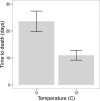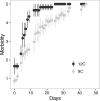Decreased Temperature Facilitates Short-Term Sea Star Wasting Disease Survival in the Keystone Intertidal Sea Star Pisaster ochraceus - PubMed (original) (raw)
Decreased Temperature Facilitates Short-Term Sea Star Wasting Disease Survival in the Keystone Intertidal Sea Star Pisaster ochraceus
Warren T Kohl et al. PLoS One. 2016.
Abstract
An extensive 2013 mass mortality event along the West Coast of North America due to Sea Star Wasting Disease (SSWD) has affected at least 20 species of sea stars. Among environmental factors potentially contributing to the timing of the current outbreak, increased coastal water temperatures are hypothesized to have contributed to previous and current outbreaks of SSWD. With a laboratory experiment, we tested whether cooler temperatures, similar to average winter temperatures, compared to average summer temperatures could slow the progression of morbidity or prevent SSWD mortality entirely in Pisaster ochraceus. Sea stars housed in cooler water progressed through SSWD states more slowly than sea stars housed at summer temperatures. However, the cooler temperature did not prevent SSWD mortality, and all stars died of the disease. Our data are consistent with experimental studies and field observations during previous and current outbreaks, and support the hypothesis that changes in coastal water temperatures have influenced one of the largest disease related mass mortality events in our oceans.
Conflict of interest statement
Competing Interests: The authors have declared that no competing interests exist.
Figures
Fig 1. Individuals of P. ochraceus with signs of SSWD.
(A) Typical arm twisting behavior involved contortions of one or more arms toward the oral disk, often observed prior to lesion spread or development. (B) ‘Corkscrew’ arm twisting, contortions were generally limited to one arm and involved the twisting of the affected arm about a central axis, and often observed immediately prior to shedding of the affected arm. (C) Shedding of one or more arms generally occurred 1–5 days after observing substantial lesioning; several individuals displayed perforated aboral lesions with protruding pyloric cecae or gonads (arrow). (D) Close-up of the wound produced by a recent arm-shedding event, solid masses of lesioned tissue (arrowheads) often appeared to close or occlude openings in the coelomic cavity, though gonads and pyloric cecae (arrow) were often observed to protrude through wounds produced by arm shedding.
Fig 2. Average time to death in each temperature treatment.
Error bars represent ± standard error.
Fig 3. Morbidity vs. time in each temperature treatment.
Error bars represent ± standard error.
Similar articles
- Large-scale impacts of sea star wasting disease (SSWD) on intertidal sea stars and implications for recovery.
Miner CM, Burnaford JL, Ambrose RF, Antrim L, Bohlmann H, Blanchette CA, Engle JM, Fradkin SC, Gaddam R, Harley CDG, Miner BG, Murray SN, Smith JR, Whitaker SG, Raimondi PT. Miner CM, et al. PLoS One. 2018 Mar 20;13(3):e0192870. doi: 10.1371/journal.pone.0192870. eCollection 2018. PLoS One. 2018. PMID: 29558484 Free PMC article. - Sea Star Wasting Disease in the Keystone Predator Pisaster ochraceus in Oregon: Insights into Differential Population Impacts, Recovery, Predation Rate, and Temperature Effects from Long-Term Research.
Menge BA, Cerny-Chipman EB, Johnson A, Sullivan J, Gravem S, Chan F. Menge BA, et al. PLoS One. 2016 May 4;11(5):e0153994. doi: 10.1371/journal.pone.0153994. eCollection 2016. PLoS One. 2016. PMID: 27144391 Free PMC article. - Reciprocal abundance shifts of the intertidal sea stars, Evasterias troschelii and Pisaster ochraceus, following sea star wasting disease.
Kay SWC, Gehman AM, Harley CDG. Kay SWC, et al. Proc Biol Sci. 2019 Apr 24;286(1901):20182766. doi: 10.1098/rspb.2018.2766. Proc Biol Sci. 2019. PMID: 31014216 Free PMC article. - A Review of Asteroid Biology in the Context of Sea Star Wasting: Possible Causes and Consequences.
Oulhen N, Byrne M, Duffin P, Gomez-Chiarri M, Hewson I, Hodin J, Konar B, Lipp EK, Miner BG, Newton AL, Schiebelhut LM, Smolowitz R, Wahltinez SJ, Wessel GM, Work TM, Zaki HA, Wares JP. Oulhen N, et al. Biol Bull. 2022 Aug;243(1):50-75. doi: 10.1086/719928. Epub 2022 Jul 22. Biol Bull. 2022. PMID: 36108034 Free PMC article. Review. - M stars as targets for terrestrial exoplanet searches and biosignature detection.
Scalo J, Kaltenegger L, Segura A, Fridlund M, Ribas I, Kulikov YN, Grenfell JL, Rauer H, Odert P, Leitzinger M, Selsis F, Khodachenko ML, Eiroa C, Kasting J, Lammer H. Scalo J, et al. Astrobiology. 2007 Feb;7(1):85-166. doi: 10.1089/ast.2006.0125. Astrobiology. 2007. PMID: 17407405 Review.
Cited by
- Sea star wasting disease demography and etiology in the brooding sea star Leptasterias spp.
Jaffe N, Eberl R, Bucholz J, Cohen CS. Jaffe N, et al. PLoS One. 2019 Nov 21;14(11):e0225248. doi: 10.1371/journal.pone.0225248. eCollection 2019. PLoS One. 2019. PMID: 31751376 Free PMC article. - Sea Star Wasting Disease in Asterias forbesi along the Atlantic Coast of North America.
Bucci C, Francoeur M, McGreal J, Smolowitz R, Zazueta-Novoa V, Wessel GM, Gomez-Chiarri M. Bucci C, et al. PLoS One. 2017 Dec 11;12(12):e0188523. doi: 10.1371/journal.pone.0188523. eCollection 2017. PLoS One. 2017. PMID: 29228006 Free PMC article. - North Pacific warming shifts the juvenile range of a marine apex predator.
Tanaka KR, Van Houtan KS, Mailander E, Dias BS, Galginaitis C, O'Sullivan J, Lowe CG, Jorgensen SJ. Tanaka KR, et al. Sci Rep. 2021 Feb 9;11(1):3373. doi: 10.1038/s41598-021-82424-9. Sci Rep. 2021. PMID: 33564038 Free PMC article. - A reference genome for ecological restoration of the sunflower sea star, Pycnopodia helianthoides.
Schiebelhut LM, DeBiasse MB, Gabriel L, Hoff KJ, Dawson MN. Schiebelhut LM, et al. J Hered. 2024 Feb 3;115(1):86-93. doi: 10.1093/jhered/esad054. J Hered. 2024. PMID: 37738158 Free PMC article. - Disease-driven mass mortality event leads to widespread extirpation and variable recovery potential of a marine predator across the eastern Pacific.
Hamilton SL, Saccomanno VR, Heady WN, Gehman AL, Lonhart SI, Beas-Luna R, Francis FT, Lee L, Rogers-Bennett L, Salomon AK, Gravem SA. Hamilton SL, et al. Proc Biol Sci. 2021 Aug 25;288(1957):20211195. doi: 10.1098/rspb.2021.1195. Epub 2021 Aug 25. Proc Biol Sci. 2021. PMID: 34428964 Free PMC article.
References
- Pacificrockyintertidal.org [Internet]. California: University of California Santa Cruz; c2013-2015 [updated 2015 November 18; cited 2015 June 9]. Available: http://www.eeb.ucsc.edu/pacificrockyintertidal/data-products/sea-star-wa...
- Eckert GL, Engle JM, Kushner DJ. 2000. Sea star disease and population declines at the Channel Islands. In: Browne D, Pierson M, Lima J, Mitchell K, Dunkel C, editors. Channel Islands. Proceedings of the 5th California Islands Symposium; 1999 Mar 29-Apr 1; Santa Barbara, CA, USA. Camarillo: US Minerals Management Service; 1999. p. 390–399.
- Staehli A, Schaerer R, Hoelzle K, Ribi G. Temperature induced disease in the starfish Astropecten jonstoni. Mar. Biodivers. Rec. 2009; 2: e78.
Publication types
MeSH terms
Grants and funding
This research was funded by a Washington Sea Grant (National Oceanic and Atmospheric Administration Award No. NA10OAR4170057) to B. Miner and C. Miner and a National Science Foundation grant OCE-1401727 to B. Miner and I. Hewson.
LinkOut - more resources
Full Text Sources
Other Literature Sources
Miscellaneous


